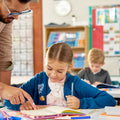In part 1 of this two-part series, we discussed ways in which we can reduce the time and energy we invest in instructing and supporting students without undermining or sacrificing their learning. However, the sources of pressure and stress we feel are not always confined to our instructional practices. We can create stress through the expectations we hold for ourselves. We can form habits and engage in behaviors that sap our energy without our realizing the price we are paying. We can even become stressed by how we view situations and circumstances over which we do not have control.
Often, just becoming aware of the source of our stress and frustration can help. At times, though, we need to step it up and give ourselves permission to let go of or at least adjust the expectations that are getting in the way of our success and satisfaction. Here are five opportunities for examination, reflection, and modification.
Opportunity #1: Stop stressing over minor interruptions and unexpected changes.
We frequently spend our energy fretting over deviations and distractions that get in the way of our plans and expectations. In response to something we could neither foresee nor control changing our day, we can either let ourselves be shadowed by a negative mood, or we can choose to adjust, refocus, and make the best of the situation. The energy we save can be reallocated to areas of greater benefit and satisfaction.
Opportunity #2: Stop overthinking.
It is inevitable that we will occasionally do or say something we regret. We will make mistakes and experience setbacks. When we do, we have a choice. We can keep replaying the situation in our minds, figuratively beating ourselves up, and wishing we could have a “do over.” Or, instead, we can make the choice to accept what happened, apologize if needed, and ask ourselves what we can learn from the situation. The time we spend regretting and replaying the situation yields little benefit; on the other hand, deciding what to learn and letting go frees us to shift our attention and energy in the direction of things we can do something about.
Opportunity #3. Stop associating with negative people.
It is true that not everyone with whom we work may be positive, optimistic, and pleasant to be around. However, we can choose to limit the time we spend with them and avoid spending any time with negative people when we have a choice. Negative people drain our energy, poison our outlook, and create frustration. The less time we spend with them, the more time and energy we have available to associate with others who feed our energy and leave us feeling better.
Opportunity #4: Stop being constantly available during evenings, weekends, and holiday breaks.
In the aftermath of the pandemic, expectations for teacher availability have become blurred and, in many cases, out of control. Students and parents may feel free to reach out during evenings or weekends with questions and requests and expect to have a response before school starts the next day. While in emergencies we want to be reachable, we can choose to provide structures and establish expectations for our work hours and times when we are available. We want to be responsive, of course, but we also can and need to set limits.
Opportunity #5: Stop maintaining the perfectly decorated classroom.
There is no question that classrooms with attractive and relevant decorations are pleasant places to be. There is even some evidence that they can help students to feel welcomed and give them a sense of belonging. However, wall-to-wall decorations and too much splash and color can become distracting. Additionally, classroom decorations do not have to be changed weekly or monthly. Giving some thought to decorations that will support learning and make students feel comfortable can be a good investment. However, classroom decorations are not the most important element in support of learning. We can afford to spend less time (and money) decorating and reallocate our energy to tasks with more learning impact.
Like the opportunities we discussed in part 1 of this series, some of these opportunities may not be sources of pressure and stress for you, or you may have already made adjustments that serve you well. It might be that your reflection on these opportunities has surfaced other sources of pressure and stress that you may want to address. If so, now is a good time to make changes and find what works for you.















